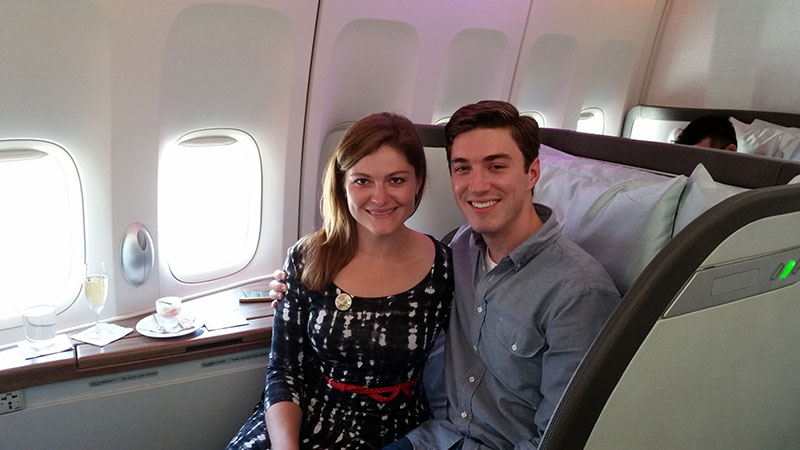How I got started as a frequent flyer
Share

My sister and I flew to Hong Kong last year in Cathay Pacific’s first class using miles. Although originally booked in business class, we later changed the award.
Scott and sister on an award trip to Hong Kong on Cathay Pacific in 2015
Although I’ve been writing my travel blog for several years, it surprises many people to learn that I first became interested in frequent flyer programs when I was a graduate student in neurobiology. It was the first time I had this much freedom to set my own schedule, and I had spent most of the last 22 years feeling a little stuck in California. I jumped on deals to far-flung places that friends sent my way and started finding my own. Applying my scientific mindset to the travel industry helped me leverage my flexibility to earn miles and elite status more quickly.
There are several kinds of loyalty programs. Some operate a type of rebate system in which rewards are linked directly to the amount spent, but this didn’t work very well for me since I was trying to book cheap tickets. Another kind, which is used by Alaska Airlines, let me earn a mile for every mile flown. That was more appealing. I taught myself to use specialized search engines like ITA Matrix to find the cheapest flights that traveled the longest distance, which is known as a “mileage run.” (Hipmunk and Google Flights share some of the same features and are easier for beginners to use.) Thanks to the first class upgrades I earned through elite status, even a long flight wasn’t too painful.
I used mileage runs to visit family, see old college friends, and even take some of my first trips to foreign countries. When a good sale means flights to London cost the same as those to New York, who wouldn’t prefer the exoticism of Europe? About half of my job involved analyzing data and writing academic manuscripts, which I could easily do on the plane. And yes, I was young. Jet lag wasn’t really an issue at the time.
Watching for these opportunities has also made it easier for me to spend more time traveling with others. My sister and I jumped on a $300 fare to Madrid and spent a month traveling through Spain, redeeming points for much nicer hotels than our student budgets allowed. I used miles to surprise my wife with her first trip to Hawaii, where I proposed at sunrise on the summit of the Haleakala crater. Our honeymoon–including first class flights and a private villa in Bali–would have cost over $30,000 had we paid cash. With miles and points? Just a few hundred dollars in taxes. (Expenses for the wedding helped us earn those miles in the first place.)
Each achievement taught me something I used to make the next trip even bigger and better than the last. And I got good at finding the sweet spot. Was it really worth earning elite status with that airline or hotel? What were the perks, and how would purchasing an extra flight today help me save money on future trips? I still had a budget, but I wanted to spend it as wisely as possible to earn the best rewards.
Still, not everyone wants to be a frequent traveler even if they want the same perks that come with it. The good news is that there’s a certain amount of inside baseball that anyone can learn, and you can do it from the comfort of your home by reading blogs and participating in communities like FlyerTalk. I got my own start as a blogger by reading and commenting on these forums, first in areas that I really understood before branching out into others. I don’t pretend to know everything–that’s what the community is for. I can reach out to friends around the globe for help with issues outside my specialty.
One of the most valuable skills I learned is how to price my own tickets by combining published fares and flight inventory, usually using a subscription service called ExpertFlyer. This is called “fare construction” and is what travel agents used to do back in the day, and what websites like AlaskaAir.com do now.
Honestly, using the airline’s search engine works well 99 percent of the time, but understanding how things work behind the curtain can offer a lot of insights into why some flights are more expensive than others. Sometimes there are only a certain number of seats left at a specific price. Other times there is a deadline to book, or a requirement that I combine one flight with another. When I finally book a ticket, I’m not just hoping I have the best price; I have the certainty that there are no cheaper options available anywhere else. And if I pay a premium to fly on a preferred carrier, it’s because I know the value of extra benefits like checked baggage and upgrades.
That kind of background knowledge is also extremely helpful when it’s time to book award travel. The price (number of miles) and the rules of the loyalty program are freely available, so no subscription is needed. All I need to do is find the inventory and piece it together. Often searching for individual flights and piecing them together into a complete itinerary is the best approach, especially for international travel. The price won’t change as long as these flights satisfy the same rules, and an agent can help me book it.
These are the sort of tips I discuss on my blog and in the articles I write for Alaska Airlines. No one can make cheap flights magically appear. But if you are clever and can do your own homework, you might find some options that the website wouldn’t suggest on its own.



